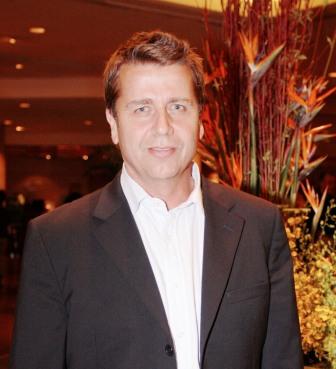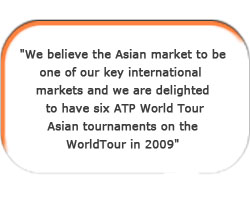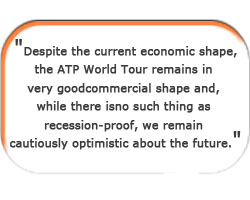
WINNER OF NINE ATP (Association of Tennis Professionals) titles, including two singles, a pin-up boy of Australian tennis in the 1980s, commentator, and now a successful entrepreneur and administrator for the game which made him famous, Brad Drewett has seen it all, from every side of the court. The CEO of the ATP’s International Group, Drewett has been responsible for bringing the Master’s Cup, the tennis season’s climax, to China.
The ATP named Brad Drewett as CEO, International Group, in January 2006 after two years of leading the region as Managing Director. It was in 1993 that Drewett began an effective stint on the ATP Board of Directors, where he established his credentials quickly. The 50-year-old Drewett has served as the Masters Cup Tournament Director since 2001, when the event was held in Sydney. In 2003 and 2004, the season-ending championship moved to Houston before returning to Shanghai in 2005 after Drewett negotiated a multi-year deal with the Shanghai Administration of Sport and Shanghai Ba-shi Industrial Company.
Based in Sydney, Drewett has established and managed successful businesses in Australia, including developing and managing tennis centers and launching a tennis court manufacturing and construction company. He has also served as a tennis expert commentator for Channel 9 (Australia) and a representative on Tennis Australia industry committees.
Drewett’s role gains immense significance in the next few years as the ATP embarks on a mission to rejuvenate the game for all its stakeholders and increase its popularity across the globe. The process has seen the ATP events being rebranded, linking tournaments to their winners’ ranking point levels of either “1000”, “500” or “250”. In the SportzPower Interview, Drewett dwells on these new business initiatives which will have a significant impact for the players, sponsors and broadcasters.
How do you expect the new format of tournaments - "1000", "500" or "250" – to help the Tour calendar?
The next season will see the ATP implement the largest set of changes since its creation. The changes are led by extensive consumer research of over 20,000 fans globally. The changes are designed to increase value to all ATP members and to ensure that fans can see the best players at best tournaments in the right weeks.
The changes to the calendar create two strong top tiers in key global markets - nine Masters 1000 tournaments in Europe, US and Asia, eleven 500s in Europe, Latin America, US and Asia, along with 41 other 250s across the world. In addition, the Barclays ATP World Tour Finals in London will act as a natural end to the European indoor season.
The calendar still looks crowded, an aspect which tends to keep the top players away from many tournaments and disappoints fans across the world.
This new schedule of events create specific and uninterrupted swings that build into each Grand Slam and the World Tour Finals, making the season flow better, making it far more understandable for fans and enables players to plan healthier schedules with less continental travel and no Davis Cup in mid-swings.
The new format specifically looks to create a better calendar post-US Open. It will feature a less congested indoor European season that climaxes with one Masters 1000 in Paris, followed by the Barclays ATP World Tour Finals in London. Additionally, by 2011 six of the top tier of Masters 1000 events will be combined men’s and women’s events – allowing fans live at home on TV to watch the world’s best players at best events.
These changes are backed by a new player commitment to participate in eight of the eight Masters 1000s and four 500s, including one post-US Open. Thus tournament promoters, TV rights holders and, above all, fans will know from 2009 that the best events will definitely feature the best players.
Will the players also benefit monetarily?
The changes are designed to increase benefit to players both schedule-wise and in proze money. The next season will see a 36% increase in direct prize money - $60.7m (2006) to $82.3m (09), as well the introduction of a multi-million dollar bonus pool and a new profit-sharing model. The Top 10 players’ 2006 schedule replicated in 2009 shows a 25-50% prize money growth for players. There are healthier on court demands now, designed to help continue the decrease in withdrawals by top players – 56 draws, which means 9 less matches a year for top 8; three-set finals; and reduction in commitment for players with long service. The new schedule means less unnecessary travel, particularly post US Open, with far less cross-continent travel.
These changes would also demand more investment into the game. Given the current global downturn, is it likely that you could face problems in this area?
The changes have sparked record levels of investment into men’s tennis. Already $1bn of investment has been committed into tennis via facility, promotional spend, prize money and other investment, making this the largest investment period in ATP history. The sport is currently enjoying unprecedented amounts of new stadium builds and upgrades. Over $800m is being spent on new stadia in Madrid, Shanghai, Brisbane, Valencia and Paris as well as upgrades in Cinci, Rome, Acapulco, Rotterdam and Canada that will deliver world class facilities for fans.
The changes also mean a better promoted sport that is positioned for further growth. The new top tiers are being packaged together in an enhanced TV package and web streaming proposition of 1000s, 500s and other key regional tournaments. This meets demand from broadcasters for more top-level tennis action to broadcast.
The next season will also see increased ATP marketing spend between 2009 to 2011 of $30m designed to realize the potential of the sport. This will include the new multi-million-dollar ATP advertising campaign FEEL IT and new consumer research-led changes to ATP World Tour identity, brand and name which will explain the Tour, its network of tournaments and ranking system better to fans and help raise the profile of sport further.
In the ongoing financial turmoil and a crowded sports market, what are the key reasons that could attract sponsors to tennis?
Statistics prove how ATP tennis is an interesting proposition for potential partners. The ATP Tour is the world’s most global, year-round sporting occasion featuring players from over 100 countries, competing at 63 tournaments in 31 countries on six continents next season. There is record total financial commitment in 2008 of $69.8 million which goes up to $104m if we include the four Grand Slams.
You have a worldwide audience of nearly 6.4 million fans who attended tournaments in 2007. The ATP Tour TV coverage also continues to grow impressively with a global cumulative TV audience of 464 million viewers who watched 30,140 hours of coverage broadcast in 184 countries. You can also include a cumulative audience of two billion for news and magazine shows. While ATPMastersSeries.tv had 1.4 million unique users, ATPtennis.com is the world’s most popular tennis website. Even 30love.net, a social network and video sharing site for tennis fans launched just last summer, has enjoyed 435,000 visits till now with 688,000 video views.
The sport provides a phenomenal reach and visibility across mediums and therefore it is not surprising that we find long-term partners who support the growth of the game.
What has been the recent response from sponsors?
 Despite the current economic shape, the ATP World Tour remains in very good commercial shape and, while there is no such thing as recession-proof, we remain cautiously optimistic about the future. Tennis is an attractive proposition for companies looking to invest in sporting properties.
Despite the current economic shape, the ATP World Tour remains in very good commercial shape and, while there is no such thing as recession-proof, we remain cautiously optimistic about the future. Tennis is an attractive proposition for companies looking to invest in sporting properties.
In the last few months we have seen a large number of existing sponsors renew three-year contracts with the ATP - companies such as Enel, Ricoh and South African Airways - all deals at or around $20m. Importantly, new sponsors have joined, such as Barclays as the new five-year, $38-million sponsor of the ATP World Tour Finals.
What are the ATP’s plans to improve and spread the game in Asia?
From 2009 the ATP World Tour will feature a new Asian swing - Shanghai Masters 1000, Tokyo 500 and Beijing 500, Bangkok 250 - in a key and rapidly developing market.
We believe the Asian market to be one of our key international markets and we are delighted to have six ATP World Tour Asian tournaments on the World Tour in 2009, including the new dedicated Asian swing, post-US Open, which will feature three of our 20 top tier events from 2009 onwards.
Gambling is prevalent in many sports today, leading to the likelihood of fixed matches. What steps is the ATP taking to combat this? Given that you have been a player before, what are your suggestions to tackle it?
We take this issue exceptionally seriously and recognize that a threat to our sport’s integrity exists, but it is important to state that we have found no evidence of any corruption in our sport. Tennis has taken a responsible and transparent approach to the issue by commissioning an independent integrity review, which we published in full, and have accepted all of that review’s 15 recommendations. We have now established an independent Integrity Unit, run by one of the world’s leading sport’s integrity experts, Jeff Rees, to ensure the integrity of tennis is preserved and have introduced a worldwide set of rules across all tennis governing bodies. We will continue to do all that we can to ensure we continue to meet the challenges we face as a sport head on.
Tell us something about your role with the ATP, as an entrepreneur and a commentator. Do you think these roles at times conflict with each other?
My current role with the ATP is as CEO of the International Group. This role means that I oversee the tournaments and players in the region and provide an advisory and strategic resource to all relevant parties. As you have noted, I have been involved with ATP most of my life, first as a player, as a Board Member and now as CEO. I am no longer a Board Member, so there is definitely no conflict in my roles. Everything I have done in my career has been complementary and provides me with the knowledge and experience to see the sport from many different angles. Tennis a fantastic sport and the ATP is an organization I am proud to have been able to contribute to over many years.

